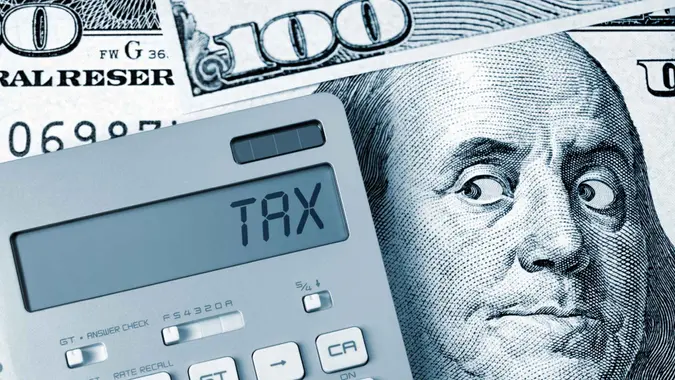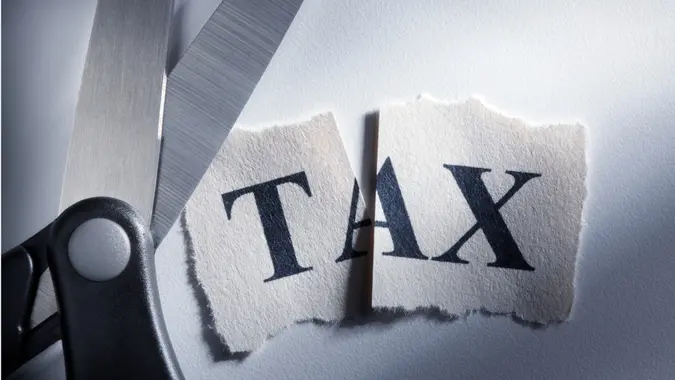IRS Tax Brackets: Federal Tax Rates and Tax Brackets for 2023-2024 Earnings

Commitment to Our Readers
GOBankingRates' editorial team is committed to bringing you unbiased reviews and information. We use data-driven methodologies to evaluate financial products and services - our reviews and ratings are not influenced by advertisers. You can read more about our editorial guidelines and our products and services review methodology.

20 Years
Helping You Live Richer

Reviewed
by Experts

Trusted by
Millions of Readers
Tax brackets are the government’s way of ensuring that taxpayers who earn more money pay more in taxes. Each bracket consists of a tax rate that’s applied to taxable income within a specific range. Those income ranges vary according to filing status — the range for a single filer is different than the range for someone filing as head of household, for example.
What Is My Tax Bracket for 2023?
Your federal income tax bracket is based on your tax filing status and your income. To help you quickly figure out which IRS income tax bracket you’re in, check the IRS federal tax table for tax year 2023 and tax year 2024.
Tax Brackets 2023
| Tax Rate | Single | Married Filing Jointly or Qualifying Surviving Spouse | Married Filing Separately | Head of Household |
|---|---|---|---|---|
| 10% | $0 to $11,000 | $0 to $22,000 | $0 to $11,000 | $0 to $15,700 |
| 12% | $11,001 to $44,725 | $22,001 to $89,450 | $11,001 to $44,725 | $15,701 to $59,850 |
| 22% | $44,726 to $95,375 | $89,451 to $190,750 | $44,726 to $95,375 | $59,851 to $95,350 |
| 24% | $95,376 to $182,100 | $190,751 to $364,200 | $95,376 to $182,100 | $95,351 to $182,100 |
| 32% | $182,101 to $231,250 | $364,201 to $462,500 | $182,101 to $231,250 | $182,101 to $231,250 |
| 35% | $231,251 to $578,125 | $462,501 to $693,750 | $231,251 to $346,875 | $231,251 to $578,100 |
| 37% | $578,126 or more | $693,751 or more | $346,876 or more | $578,101 or more |
Tax Brackets 2024
| Tax Rate | Single | Married Filing Jointly or Qualifying Surviving Spouse | Married Filing Separately | Head of Household |
|---|---|---|---|---|
| 10% | $0 to $11,600 | $0 to $23,200 | $0 to $11,600 | $0 to $16,550 |
| 12% | $11,601 to $47,150 | $23,201 to $94,300 | $11,601 to $47,150 | $16,551 to $63,100 |
| 22% | $47,151 to $100,525 | $94,301 to $201,050 | $47,151 to $100,525 | $63,101 to $100,500 |
| 24% | $100,526 to $191,950 | $201,051 to $383,900 | $100,526 to $191,950 | $100,501 to $191,950 |
| 32% | $191,951 to $243,725 | $383,901 to $487,450 | $191,951 to $243,725 | $191,951 to $243,700 |
| 35% | $243,726 to $609,350 | $487,451 to $731,200 | $243,726 to $365,600 | $243,701 to $609,350 |
| 37% | $609,351 or more | $731,201 or more | $365,601 or more | $609,351 or more |
What Is a Tax Bracket?
The U.S. uses federal income tax brackets to determine your tax liability. IRS tax brackets are divided based on your taxable income level, with different incomes taxed at different federal income tax rates. There are seven brackets for 2023 earnings, ranging from 10% to 37%.
How Tax Brackets Work
The IRS applies tax brackets to your adjusted gross income — the taxable amount that remains after deductions, credits and exemptions. However, because tax rates are tiered, the rate for a particular tax bracket only applies to the amount of income within that bracket. So if you have more than $11,000 in taxable income, only the first $11,000 is taxed at the 10% rate. The rest is taxed at the rate for whichever bracket the amount falls into.
Take, for example, a single filer with an adjusted gross income of $60,000. Although $60,000 falls within the 22% tax bracket, only income that falls within the range for the 22% bracket gets taxed at the 22% rate. The first $11,000 is taxed at 10%. The next $33,724, which is the amount represented by the 12% bracket ($44,725 – $11,001 = $33,724), is taxed at 12%. The last $15,274 ($60,000 – $44,726) is taxed at 22%.
Knowing where you stand within your income threshold will help when it comes to navigating how much you’ll owe or standard deductions. Keep in mind higher tax brackets are less likely to get rebates. These brackets are only based on income and don’t include nuances such as tax cuts for the Jobs Act or other assistance programs.
Final Take To GO
Knowing your effective tax rate can help you estimate your federal tax liability, but it doesn’t provide the information you need to calculate how much tax you should have withheld from your pay.
For that, use the IRS tax withholding estimator to compare your options — married filing jointly vs. married filing separate returns, for example. Then use the most favorable scenario to fill out a Form W-4. Your employer will calculate the correct withholding based on your preferences.
You might be able to lower your tax bracket by reducing your taxable income. The IRS gives you several ways to do that:
- Claim all the legal deductions you’re entitled to, such as charitable donations, home business costs and some education-related expenses.
- Contribute to tax-deferred retirement accounts such as a 401(k) or an individual retirement account.
- Claim any tax credits you qualify for, such as the child tax credit, earned income tax credit and credit for qualified educational expenses and retirement savings contributions.
- If you’re married, calculate your taxes using both filing statuses — married filing jointly and married filing separately — and compare the results. In some cases, one status results in a lower tax liability than the other.
FAQ
Here are the answers to some of the most frequently asked questions about taxes.- What are the IRS income tax brackets for 2023?
- The 2023 federal tax brackets for single filers are as follows:
- 10% for incomes between $0 and $11,000.
- 12% for incomes between $11,001 to $44,725.
- 22% for incomes between $44,726 to $95,375.
- 24% for incomes between $95,376 to $182,100.
- 32% for incomes between $$182,101 to $231,250.
- 35% for incomes between $$231,251 to $578,125.
- 37% for incomes of $578,126 or more.
- The 2023 federal tax brackets for single filers are as follows:
- How much should be taken out of your paycheck for taxes?
- The amount of taxes that are taken out of your paycheck depends on how many allowances you claimed on your W-4. If you claimed zero, you indicated that you want the most amount of tax taken out of your pay each period. Claiming one means less tax is taken out. The ideal amount would come down to your budgeting needs and personal preference.
- What is a marginal tax rate?
- Your marginal tax rate is the tax rate that applies to your last $1 of adjusted gross income.
- What is an effective tax rate?
- An effective tax rate is the average rate you pay on your adjusted gross income. To calculate it, you would divide your total tax bill by your taxable income. Keep in mind that the final rate is always lower than your marginal tax rate.
- What are all seven tax brackets?
- The seven tax brackets are 10%, 12%, 22%, 24%, 32%, 35% and 37%.
Krista Baum, Daria Uhlig and John Csiszar contributed to the reporting for this article.
Information is accurate as of Feb. 20, 2024.
Our in-house research team and on-site financial experts work together to create content that’s accurate, impartial, and up to date. We fact-check every single statistic, quote and fact using trusted primary resources to make sure the information we provide is correct. You can learn more about GOBankingRates’ processes and standards in our editorial policy.
- TurboTax. 2022. "Understanding Progressive, Regressive, and Flat Taxes."
- IRS. 2022. "IRS provides tax inflation adjustments for tax year 2023."
- Tax Policy Center. "What are marriage penalties and bonuses?"
- IRS. "Credits and Deductions for Individuals."
- Fidelity. 2024. "2023 and 2024 tax brackets and federal income tax rates."
- IRS. 2024. "Federal income tax rates and brackets."
 Written by
Written by  Edited by
Edited by 


























